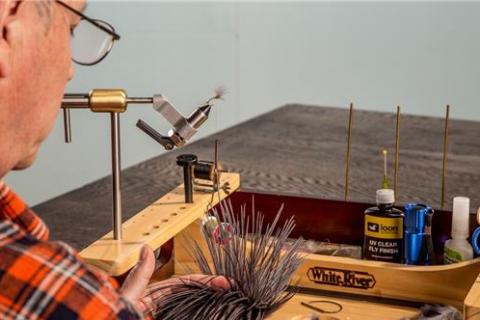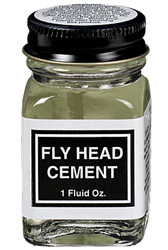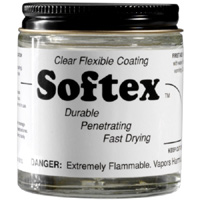
 |
| Epoxies and cements like Fly Head Cement can bulletproof the heads of your fly patterns, preventing threads from unraveling. |
If you were to step into an average fly fishing shop and ask to see their assortment of fly-tying glues and adhesives, you'd probably be stunned by the number of products that get shuffled your way. Flexible cements, super glues and hard-set epoxies are just a few examples of different adhesives available to the creative fly tier.
Looking back over the history of fly tying, adhesives were not commonly incorporated into flies. Legendary tiers such as Frederick Halford and Theodore Gordan created many fantastic flies over their many years of tying, yet never once did a product as simple as head cement touch a thread wrap.
If you look at using adhesives for fly tying critically, longevity is the first point that should come to mind. Most fly hackles and body wraps do not last more than a few fish, but with the advantages of new adhesives, traditional patterns can be transformed to withstand punishment from the toothiest fish.
New epoxies and cements can bulletproof the heads of fly patterns to prevent unraveling of threads. Flexible cements allow delicate materials to be sculpted like never before, while also changing the buoyancy of your flies in the water.
Head Cements for Fly Tying
Every fly fisherman at one time or another has had their favorite fly come out of a snag or fishes mouth with the body materials and tying thread unraveled, leaving a shaggy hook shank that could never fool a wise fish. That's why over the last 30 to 40 years head cement has increasingly been used to seal the final wraps of thread placed on to the head of the fly.
Head cements for fly tying need to be applied to flies in multiple applications, building layer-over-layer of cement for maximum protection. Head cement can also be used in flies when working with hard-to-use materials such as buck-tail or calf-tail fibers. With these types of materials, strong thread pressure is needed to hold the material in place, while a few drops of head cement at the tie-on point helps keep things in place a little better than the tying thread alone.
One of the great advantages of head cements over other adhesives is that it is very thin-bodied, meaning it can be applied to flies very easily and minimally, reducing the bulk to flies without compromising strength. Needle applicators or fine tipped brushes do a great job of applying head cement in hard-to-reach areas.
Flexible Cements for Fly Tying
Flexible adheasives or cements are relatively new to the fly-tying world, and the possible applications for flexible cements are almost endless. In most cases, flexible cements are used to fix feathers in which tiers want to bend, cut and sculpt into a desired shape. These cement-coated feathers are mainly used for wing cases, spent wings or nymph exoskeletons.
 |
| When tying saltwater fly patterns, flexible adhesives like Softex are used to coat the heads of flies to create realistic, durable minnow patterns. |
If a small amount is applied and allowed to penetrate into the fibers, flexible cements can also be used to aid in the durability of flies. When tying saltwater patterns, flexible cements can be used to coat the heads of flies, creating a realistic and very durable minnow pattern. If you are going to attach stick-on eyes to the head, it is a good idea to coat the entire head in flexible cement after the eyes are in place. This quick coating will seal the head of the fly and hold the eyes in place.
Flexible cements can be applied to flies in the same way that regular head cements are applied, but tiers need to be conscious not create too much bulk to their patterns due to the consistency of the adhesive.
Super Glue for Fly Tying
This special adhesive has been around most households for the last few decades, but only recently made its way into fly-tying stations. Tiers should be very careful when using super glue on their fly patterns because this adhesive does not allow tiers much time to work. Super glues set up in seconds, which can be very beneficial in some situations and a nightmare in others.
Ideally, super glues are used to hold materials in place before the thread is wrapped around them to secure them tightly. Plastic stick eyes, standing wings or nymph legs are just a few examples of regular applications of super glues. Apply only a small amount of super glue to your fly as this adhesive seems to spread everywhere, sticking down all your materials and tools.
5-Minute Epoxy for Fly Tying
Of all the adhesives, epoxy has been the hottest in fly tying over the last few years. With the explosion of saltwater fly fishing, the need for bulky, durable flies has increased ten-fold. Epoxy is a wonderful adhesive for fly tiers and has varied uses, which includes building bodies, holding materials to bulletproofing heads.
One of the main disadvantages of using epoxy is that fly tiers have to go through a crash course in how to handle this tricky substance. The first snag to overcome is the mixing of the two different parts of this adhesive -- too much of either one of the two additives, or not thoroughly mixing, and the epoxy will not set correctly and ruin all your hard work.
The second disadvantage is that a five-minute epoxy sets up in...well, five minutes. This means meaning you have to find a way to hold the cement in the exact spot you want for the duration of those five minutes. The use of monofilament frames and epoxy driers allow the skilled tier to create realistic minnow/fry patterns that can withstand the most vicious aquatic predators.
With large saltwater patterns or trolling flies, bulletproofing the heads of flies is a necessity in order to keep all the tailing or body fibers from being pulled free from the fly. Epoxy is best applied to flies with a bodkin and hand turn for the first few minutes until the epoxy has started to gel, or the desired shape is achieved.
Hot Melt Glue
Hot melt glues have a very limited use in fly-tying. However, for egg patterns there's no better way to create a realistic imitation. These special adhesives are great for creating single egg or egg cluster patterns with a few simple turns of the wrist. Egg patterns are especially easy to tie, and are relativity durable in the water.
There is no real mystery behind the use of adhesives in fly tying. Although a tier can create great-looking and durable flies with thread control, half hitches and whip finishes, specialty glues open up a whole new world of realism for the creative fly tier. Take it slow, practice lots, and in a little time, your flies will be better looking, last longer and definitely catch more fish.
- 11131 views

